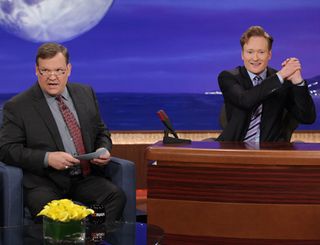Stations Take Conan Barbs to Heart

RELATED: Poynter Teaching Reporters To Shoot Straight
The video clips are very viral and, as the slogan of Conan O’Brien’s home network goes, very funny: O’Brien mocking local TV news with clips of dozens of anchors, whether they’re in Tampa or Topeka, uttering identical, and often inane, phrases. O’Brien’s most recent “Local News Round-Up,” showing anchors delivering Austin Powers’ famous “Yeah, baby!” to introduce a story on actor Mike Myers and his wife having a new child, has garnered more than 2 million online views. “Local news found a really unique way to tell the story,” mocked the TBS late-night host.
Previous segments have shown copycat anchors positing, “Could this be the end of email overload?” and wondering, “Is it time for dogs to have a social network of their own?” While the clips are good for a laugh, some in local television wonder how much they reinforce the notion that local TV news is unoriginal and uninspired. “I cringe—it does make us look silly,” says Bob Sullivan, Scripps VP of programming. “More importantly, it makes us look lazy and homogeneous. And I don’t think that’s good.”
Get Me Rewrite!
Sullivan says he has not seen a Scripps station pop up in the Conan clips. Other stations, such as KTAB Abilene (Kansas) and WIS Columbia (S.C.), are not so lucky. Stations receive a feed from a wire service—such as CNN News Source, the AP or CBS Newspath—and anchors in the clips simply read the script without changing it. Clip search services such as SnapStream help Conan staffers compile the reel.
Delivering wire copy on air, known as “ripping and reading,” has been going on as long as there has been TV (and radio) news. But station newsrooms are under increasing pressure to produce content; the typical TV station airs around five hours of local news a weekday, according to a study from RTDNA/Hofstra University, while TV station new hires are down an average of 0.6 bodies this year compared to 2012 staffing figures.
Tasked with producing more content with flat head counts, the practice of ripping and reading may be more widespread than in years past. “People are slamming newscasts together,” says Al Tompkins, senior faculty, broadcast and online, at journalism resource center Poynter Institute. “It’s continually, ‘add another half-hour, add another half-hour,’ but there’s not the staff to do it.”
Broadcasting & Cable Newsletter
The smarter way to stay on top of broadcasting and cable industry. Sign up below
One veteran local news exec who asked not to be named said the clips O’Brien highlights are often from the very end of a newscast and do not appear on multiple stations in a market. “This has gone on every day for the history of television,” he says. “I kind of laugh, but to me it’s a cheap shot. Does what [O’Brien] does make good TV? Yes. Is it honest? Not really.” (Through a TBS representative, O’Brien declined to comment.)
Cue the Cringe
Industry watchers note that Conan’s young, hip audience may not watch much local news, but the clips are so widely consumed that they raise the issue of how much they affect the credibility of local TV outlets among viewers. Some wonder why newsgatherers aren’t taking the time to tailor a story to the market, or why they are reporting on a Hollywood newborn in the first place.
“When heard one after another, it really casts us in a bad light,” says Mark Platte, news director at KGMB-KHNL-KFVE Honolulu. “I personally cringe every time I see one of these segments and try to make sure that our anchors never turn up on Conan.”
Stick with original local news, and an anchor probably will not get his or her five seconds of infamy in Conan’s Local News Round-Up. “The single best way to avoid [Conan] is, cover local news in a way no one else is doing,” Tompkins says. “Be who you are—not what the wire service is.”
Michael Malone, senior content producer at B+C/Multichannel News, covers network programming, including entertainment, news and sports on broadcast, cable and streaming; and local broadcast television. He hosts the podcasts Busted Pilot, about what’s new in television, and Series Business, a chat with the creator of a new program, and writes the column “The Watchman.” He joined B+C in 2005. His journalism has also appeared in The New York Times, The Philadelphia Inquirer, Playboy and New York magazine.

